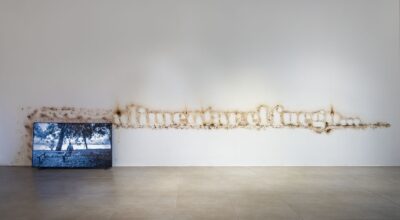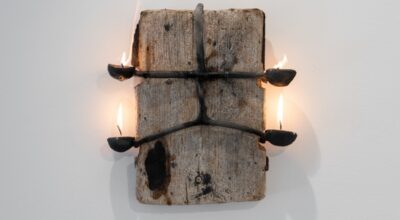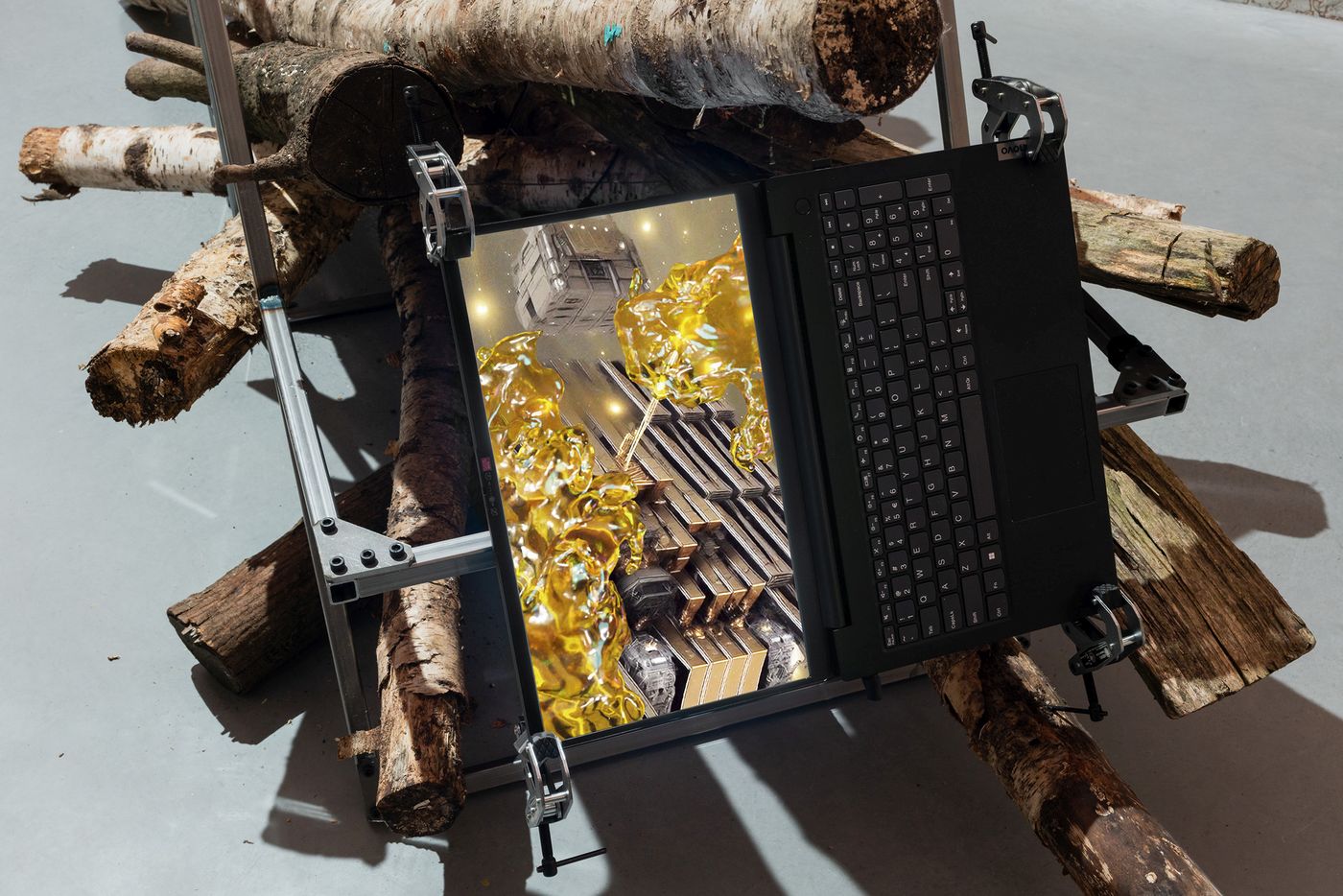
OSCAR SANTILLÁN: A HEAVY HALO
Oscar Santillan’s exhibition A Heavy Halo extends several points of enquiry to think about the ways we entangle the artificial and the organic in light of urgent ecological changes for sustainable interspecies futures. Shunning the Eurocentric and the dichotomous, A Heavy Halo -on view at RADIUS (NL)- is an insightful exploration of the margins of knowledge production and meaning-making that characterise Santillán’s practice.
Sergi Pera Rusca
Under the umbrella of studio Antimundo, which encompasses both his artistic practice and the more-than-human network he collaborates with, Oscar Santillán investigates and reconsiders material, linguistic and technological entities and relationships in the formation of worldviews. Involving Artificial Intelligence, Andean knowledges, cybernetics, and science fiction, Santillán inscribes a plurality of philosophical and material lures onto a political ecology of agencies.
With an ever-enquiring transhistorical and transdisciplinary practice, Santillán’s work is a generative means to expand our awareness of the diverse entanglements between natures and cultures, across times, bodies, and technologies. Presenting both existing and new work, the exhibition A heavy halo is conceived as an exploration into the material and epistemic interfaces between world registers.
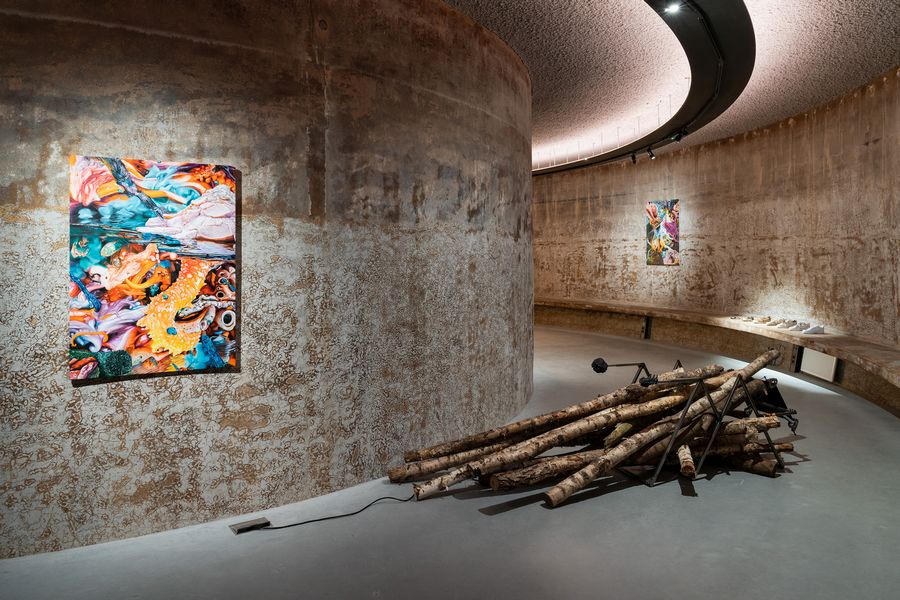
Contemporary anthropology has been experiencing a so-called “ontological turn”, which advocates for simultaneous and entangled realities and ways of being instead of interpretations of a singular natural world. Faced with the progressive encroachment of multiple ecological crises, esteemed authors such as Marilyn Starthern, Bruno Latour, Philippe Descola, Eduardo Viveiros de Castro, Marisol de la Cadena and Tim Ingold have been emphasizing the necessity to embrace ontologies, knowledges, and practices of different Indigenous peoples around the planet.
The European enlightened modern worldview has turned out to be incapable to cope with the critical state of the Earth, precisely because its intellectual foundation is based on a subordinate relationship with it. After the European scientific revolution during the 16th and 17th centuries, the idea of a single view of nature that had to be demystified and ‘managed’ was at the core of natural sciences.[1]
This singular view of nature assumed a monolithic nature and cosmos that are the result of a series of biological, physical, and chemical mechanisms that can be revealed through rational methods. Argued as a revelation for the progress of mankind, the removal of the human vis-à-vis other species and the physical environment, as well as its repositioning as external observer and master of the world, generated the separation between nature and culture.
The philosophical and material fracture between nature and culture in Europe, and its forced establishment to other territories via colonialism, established what sociologist John Law has called “the one-world world”: a world that has granted itself the right to assimilate all other worlds, and by presenting itself as exclusive, cancels possibilities for what lies beyond its limits.[2]

Against the one-world world, the embracement of a pluriverse becomes an urgency. It is in the definition of pluriverse given by Marisol de la Cadena where we can start to comprehend Oscar Santillán’s artistic practice: a composite of heterogeneous worldings coming together as a political ecology of practices, negotiating their difficult being together in heterogeneity.[3]
The one-world world conceives technological development as a universal means for progress. Philosopher Yuk Hui argues that the Earth and the cosmos have been turned into an enormous technological system, which he regards as the culmination of the schism between nature and culture brought by modernity.
However, technology is not universal, as it is both enabled and constrained by particular cosmologies. As a result, “there is no single technology, but rather multiple cosmotechnics”, that is, the conception of the cosmos and morality through technology.[4] In vein with Hui’s thinking, Oscar Santillán reminds us that in order to reconsider our cosmological narrations of the Earth we ought to pay attention to the technologies that enable them.
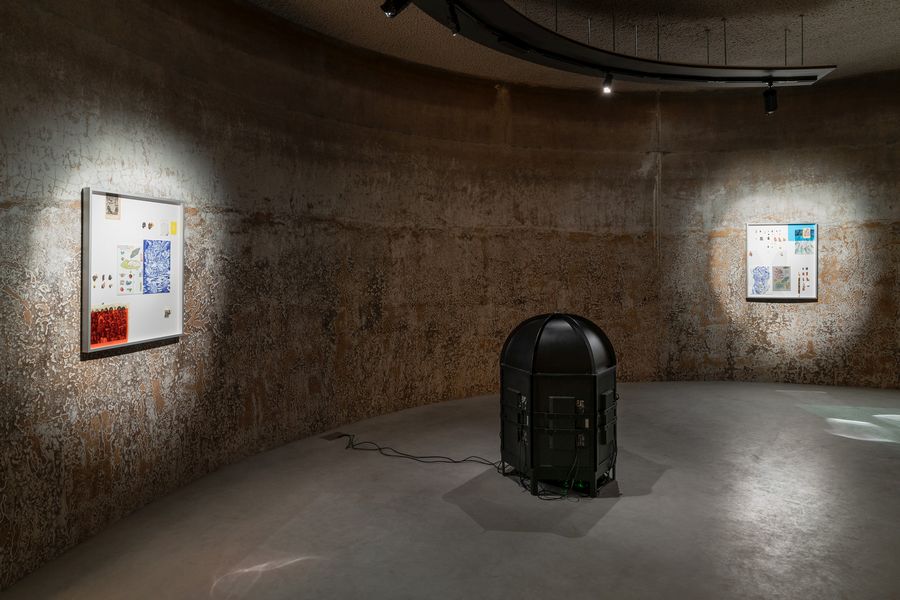
Oscar Santillán’s practice of studio Antimundo consists of an intricate reorientation of the languages of ecology towards notions of reciprocity and relationally between human and other-than-human beings. With an acute interest in the histories and developments of both ancient and contemporary technologies, Santillán’s work is a fascinating approach to the affective capacity of art to grasp and practice worlding. In order to identify and generate realities that do not fit in the one-world world, Santillán resorts to tools and imaginaries beyond the Western paradigm. As he describes it, studio Antimundo is attentive to what grows on the periphery of our normative realities and futures.
The exhibition A heavy halo extends several points of enquiry to think about the ways we entangle the artificial and the organic in light of urgent ecological changes for sustainable interspecies futures. Shunning the Eurocentric and the dichotomous, A heavy halo is an insightful exploration of the margins of knowledge production and meaning-making that characterize Santillán’s practice.
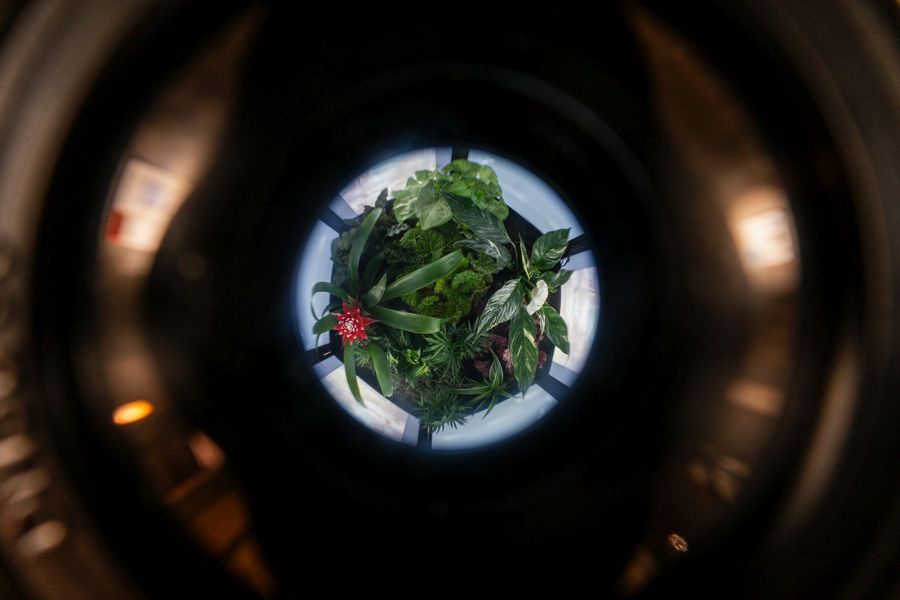
Empirical enquiry—gathering knowledge from human experience—was the turning factor in European sciences. Registering one single nature, the one-world world was absorbed into the natural sciences, including ecology in the nineteenth century. Impulsed by modernity’s mechanistic view of nature, the complexity of nature’s appearance could be revealed in a process of singularization. Isolated through the technologies of modern science, the mystery of creation was no longer.
Forecast (2021) reflects on the history of Western singularization ofnature via a specific technology of ecological deterritorialization: the Wardian case. Proposed by British physician Nathaniel Bagshaw Ward in the early nineteenth century, the Wardian case was an invention fostered by the urge to transport foreign plants from colonies overseas to Europe for their study and exhibition. Previously proven a difficult endeavour as plants could not survive the long voyages without light and freshwater, the Wardian case, conceived as a small-scale greenhouse, turned out to be an effective solution.
Contrary to the original see-through design, Forecast is an opaque case made of dark metal. Ominously alluring, the only way to see what lies inside is to bring the eye to the zenithal peephole. What becomes visible is a glowing garden composed by begonias, bromeliads, zebra plants, lilies, and other plants native to former European settlements across Central and South America, Indonesia, India, China, and Brazil.
The plants are lit by six television screens displaying apocalyptic films. Haunted by the sounds of horror and kept alive by the blaze of the end of the world, Forecast’s colonial garden harkens back to the ecological violence caused by the objectification of nature while hinting at their survival beyond the man-made devastation of the Earth.

The Andean Information Age (2021 – ongoing) is a multifaceted project thatbegan in 2018 with a collaboration between Oscar Santillán and curator Alessandra Troncone to research khipus. Khipus—meaning knots in Quechua— are devices made from ropes and knots that were used to record information by a number of Andean cultures, compromising territories connected by the Andean mountain range, what are nowadays Ecuador, Bolivia, Venezuela, Colombia, Peru, Chile, and Argentina.
Khipus, which would range from a few to thousands of ropes, had a fundamental role for the Inca people as they were the main means to collect data such as census records, calendrical information, taxes, and military organisation. Numbers and other values were encoded in the ropes as knots. Depending on their position and their twisting, as well as other indicators such as the colour or texture, different meaning and references were recorded and archived. Khipus were used extensively throughout the Andes for more than four thousand years until their eradication by Spanish colonisers between the sixteenth and eighteenth century. Only a small number of khipus have been preserved.
The first iteration of The Andean Information Age was an eponymous publication in 2020. Fragments of the publication were later transformed into the script for an installation made up of a large vertical screen and an analog 35mm slide projector. The projector has been hacked so that the slides are timed and synchronised with sound. The projected images, made with 3D software incorporating artificial intelligence, are virtual materialisations of khipus and wak’as.
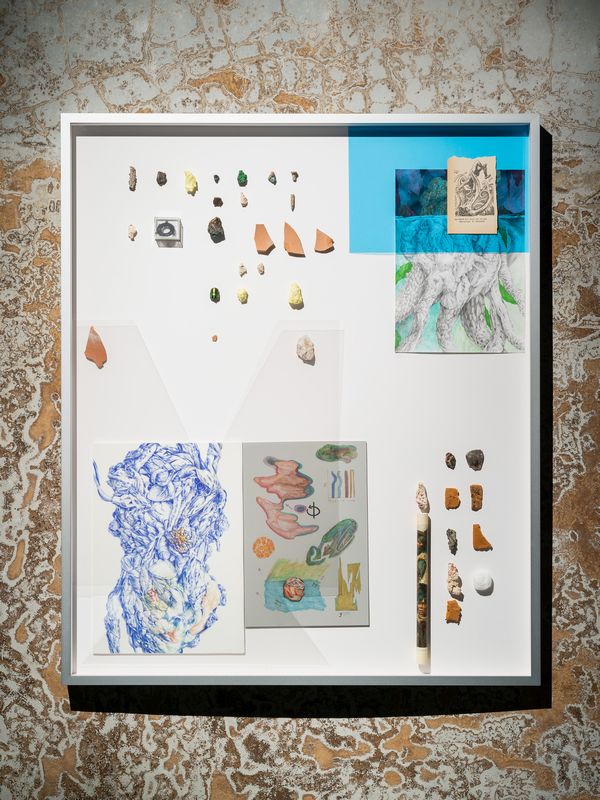
In Andean cosmologies, wak’as designate agentive, other-than-human entities that are part of the social and spiritual life of Andean peoples. Entailing idols, statues, sacred places, images, prayers, and other things that surpassed the modern European ontological parameters, wak’as were baffling to Spanish clerics who were trying to grasp Indigenous spiritual beliefs and rites. They were impossible to describe and index as they had no empirical and biological essence to them. Their destruction, therefore, became a frustrating and impossible endeavour. Unlike anthropomorphic Western representations of the sacred belonging to a higher, ineffable reality, wak’as are a reality in themselves, shaping historicity, tradition, time reckoning, spirituality, and genealogy, in both material and immaterial manifestations.[5]
Interested in the limits of language and imagination to describe wak’as, Santillán turned to A.I. to allow for these ecological entities to assume form. As a set of recurrent questions in his practice, The Andean Information Age asks: What is the connection between ancient and emerging technologies? What are the potential connection between khipus and wak’as and A.I.? What kind of futures can be enacted in a khipu, then and now, materially and virtually? In direct connection, Antibeing 0A and Antimundo 0A, two light boxes with printed imagery of virtual wak’as and khipus, are presented alongside the projection. Furthermore, the frames of the lightboxes are based on traditional Andean weaving.
Khipus and wak’as could be seen as evocative incarnations of current strands in philosophical materialism, led by figures like physicist and feminist scholar Karen Barad, whose research in quantum physics reworks the notions of matter and meaning as previously defined in natural sciences, social sciences, and humanities. For Barad, “matter and meaning are not separate elements. They are inextricably fused together […] Mattering is simultaneously a matter of substance and significance…”.[6] Do khipus and wak’as, existing as far as we know since 2600 BC, epitomise such findings of 21st century quantum physics, and can Artificial Intelligence express such entanglements in ways that human imagination cannot reach?
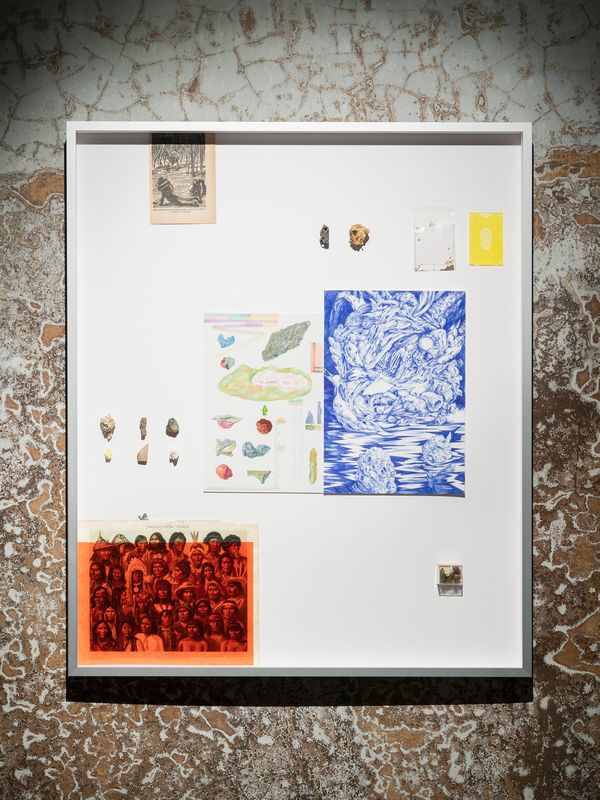
Andean cosmologies are fundamentally anti-taxonomical. This quality is well exemplified in the Quechua term ayllu, which designates bonds of kinship ubiquitously across the Andes. Ayllu, however, encompasses more than just human genealogies. It refers to the quality of all beings, human and other-than-human, to not only exist individually because they are inherently connected to one another.
Ayllu refers to the entanglement between beings as well as the act of becoming entangled; ayllu is a noun and a verb, a way of being and doing.[7] Such ontology cannot be indexed in self-enclosed categories, contrary to the binomial nomenclature, the modern system of naming organisms developed and published by Swedish taxonomist Carl Linnaeus in 1735 in his book Systema Naturae.[8]
In his exhaustive endeavour of classifying all living species apart from the human, Linnaeus outlined a hierarchical classification of the natural world, dividing it into three kingdoms: animal, plant, and mineral. Frequently quoted to have said “God created, Linnaeus organised”, his classification system was reedited several times and became widely popular throughout European knowledge institutions.
Peculiarly, Systema Naturae included a fourth realm of beings that could not be classified under the three kingdoms. Under the umbrella of Paradoxa, he listed mythical, magical, and suspicious species of hybrid creatures, mostly taken from medieval bestiaries and reports from explorers. An attempt to offer a ‘natural’ and ‘rational’ explanation for these creatures to demystify the world, Paradoxa was however excluded from the compendium after its fifth edition. Paradoxa is proof of the contradictions and faultiness of taxonomical categorisation, yet Linnaeus’ legacy still reverberates in contemporary times.
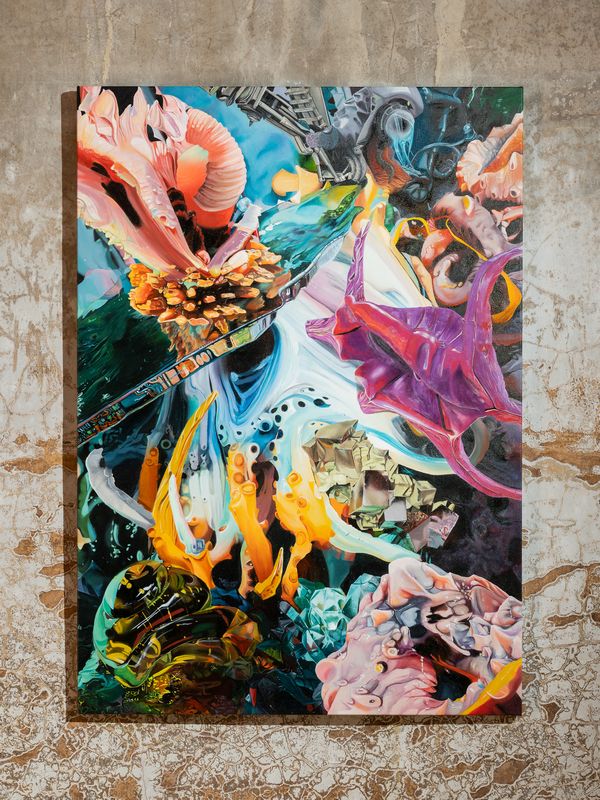
In the current developments of Artificial Intelligence, language processing tools like ChatGPT are also revealing the flaws and limits of human classification systems. Learning from the textual input of its users, ChatGPT is able to integrate related concepts into linguistic clusters that are uncategorisable under human parameters. Once again, human classification of the world meets its finitude in paradoxes.
Oscar Santillán’s Antimundo, a series of drawings and paintings, attempts to create approximations to that ‘paradoxa’, while defying the Western conventions under which ‘nature’ has been historically represented. The imagery of the Antimundo works is first generated by artificial neural networks and afterwards oil painted manually on canvas.[9]
By bringing the virtual back to a physical reality through the medium of painting, Santillán continues the tradition of painting as the preferred artistic means to represent nature throughout history. In close connection to the pieces from The Andean Information Age, the paintings from Antimundo reveal anti-taxonomical entities that relate to the Andean holistic world-making, where all that conforms the Earth is considered a sentient entity—tirakuna in Quechua, which Marisol de la Cadena translates as Earth-beings, of which wak’as are part.
Just like the evidence of the Andean holistic ontologies lies in the reciprocity that is needed between beings to live—what biology has coined symbiosis—the Antimundo series exemplifies the intrinsic mutuality that shapes Santillán’s practice. Not only does Santillán rely on the contribution from Artificial Intelligence systems, but also on the work of studio colleagues in Ecuador that help with the manual painting.

In his endeavour of bridging histories in non-linear ways, Oscar Santillán’s practice acquires an archeological quality. While traditional archeology has a vertical complexion of digging out artefacts to the surface, Santillán’s is a future archeology of multiple timelines meeting in the present. In 1’111,111, the same model shoe has been aged exponentially to the tenth power. Starting from a brand-new model, it is followed by the same shoe in ten years, one hundred, one thousand, ten thousand, one hundred thousand, and one million years finally. An apparently banal, mass-produced shoe becomes an omen of a future fossil.
The initial trigger for this work came from the artist being introduced to actual “time machines”—weather and UV light accelerators—at the Delft University of Technology (TU). These machines are often used to test materials used in industries such as aeronautics to simulate the passing of time by exposing them to unusual high amounts of UV light and other weather-related conditions.
Taking inspiration from the weather accelerators at TU, Santillán turned to the startup Spark904, an Amsterdam-based team of chemists. Different chemical mixes were developed in order to expose the shoes to their respective time-traveling age. In this way, we, the observers in the present, are confronted with the material condensation of different material futures happening at once before our eyes.
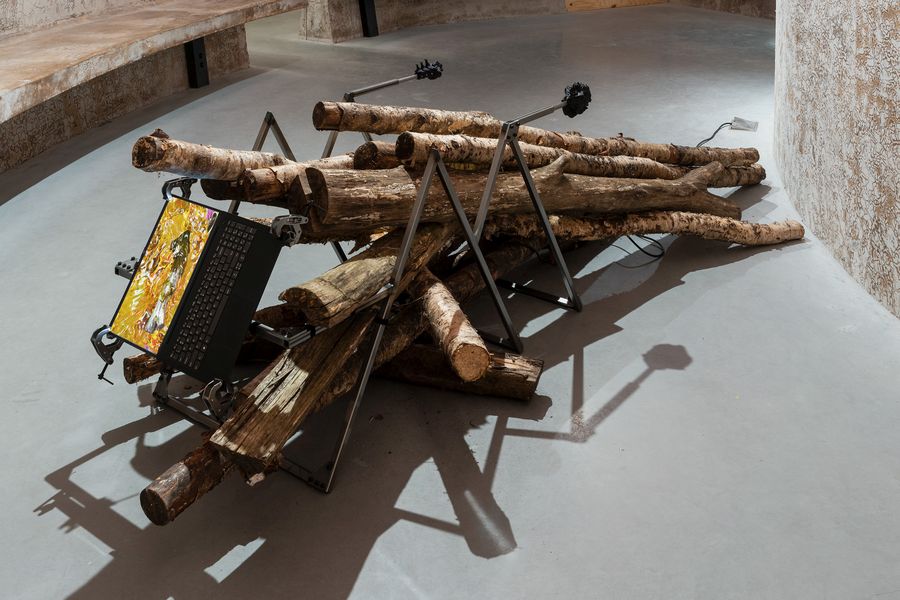
As Oscar Santillán states it, Artificial Intelligence can be understood as the sum of minerals plus mathematics. Under different promises of a more “efficient”, “fast”, and “smart” socioeconomic organisation, A.I. is announced as the next milestone of human progress. What kind of progress can it bring, though, when it is still understood under the rubric of the one-world world?
Undeniably, A.I. has the potential to optimise sectors in more sustainable ways, as much as it can improve warfare and resource exploitation. On the other hand, A.I. is far from an immaterial entity, as it is of the Earth as much as fossil fuel and water, given that it relies on manifold minerals for its composition, as well as huge amounts of energy.
In Blister, Oscar Santillán highlights the earth-bound quality of A.I. systems. On a laptop screen, we see a video generated by a combination of neural networks and 3D software. The video is displayed in the very same laptop in which this digital aspect of the piece was originally made, and it is physically held by a metal structure filled with found wooden logs. The logs are evocative of our surrounding ecologies, and given their common burning for fuel, they too evoke what was perhaps the most important technology for our ancestors: fire.
On the other side of the sculpture, two highly detailed 3D prints reveal a trans-species presence composed of minerals, bones, biological and robotic elements, and undefined forms. By layering physical and synthetic realities together, Blister is an emphatic prompt to the obstinate Earthly relationship between the divergent systems that compose our planet.
It could be argued that the investment in technologies of Artificial Intelligence and virtual reality offer an apparently enticing promise of the dematerialisation of the world under a new digital regime, so as to perpetuate capitalism beyond the limited physical resources of the Earth. Enterprises like the ‘metaverse’, a reformulation of the Internet as a single, universal, and immersive virtual world granted by virtual reality and augmented reality headsets, are but a transference of the one-world world into a virtual realm.
As philosopher Reza Negarestani argues, the metaverse and similar projects are designed for an essentialist anthropocentrism to persevere. In other words, the replication of the characteristics of human experience in what is thought to be a radical non-anthropocentric model of general intelligence.[10]
OSCAR SANTILLÁN: A HEAVY HALO
RADIUS, Center for Contemporary Art and Ecology, Kalverbos 20, Delft, The Netherlands
27 May – 20 August 2023
Curated by Niekolaas Johannes Lekkerkerk, assisted by Sergi Pera Rusca.
This exhibition has been made possible with the additional support of the Mondriaan Fund and Copperfield Gallery.
[1] John Law and Marianne Lien, “Denaturalizing Nature”, in: A World of Many Worlds, ed. Marisol de la Cadena and Mario Blaser, Duke University Press, 2018, p. 51.
[2] John Law, “Wrong with a One-World World?”, in: Distinktion: Scandinavian Journal of Social Theory 16, no. 1 (2015), pp. 126-139.
[3] Marisol de la Cadena and Mario Blaser (eds.), A World of Many Worlds, Duke University Press, 2018.
[4] Yuk Hui, Cosmotechnics and Cosmopolitics, e-flux journal 86. 2017.
[5] For further information and research on wak’as, we recommend The Archeology of Wak’as: Exploration of the Sacred in the Pre-Columbian Andes (2015).
[6] Karen Barad, Meeting the Universe Halfway. Quantum Physics and the Entanglement of Matter and Meaning, Duke University Press, 2007, p. 20.
[7] For further information on ayllu and other Andean terms, we recommend Marisol de la Cadena’s book Earth Beings: Ecologies of Practice Across Andean Worlds (2015).
[8] Formal system of naming species of living things by giving each a name composed of two parts, both of which use Latin grammatical forms.
[9] Neural networks, also known as artificial neu-ral networks (ANNs) or simulated neural networks (SNNs), are part of machine learning and key to deep learning algorithms. Their name and structure are inspired by the human brain, mimicking the way that biological neurones signal to one another.
[10] Further insights can be found in Reza Negarestani’s book Intelligence and Spirit (2018), edited by MIT Press.
También te puede interesar
ROSELL MESSEGUER Y FABIANO KUEVA: QUEMAR LA TIERRA
El fuego crea y destruye, hace y deshace, abriga y quema; el fuego es un acto de impresión profunda, es el hogar y la guerra y —en muchas ocasiones históricas— ha sido el gran...
LEO MOYANO Y PILAR ELGUETA INICIAN INTERCAMBIO ENTRE GALERÍAS DE CHILE Y ECUADOR
Como parte de una serie de intercambios y residencias que realiza Galería NAC con diferentes galerías latinoamericanas, se presenta en su espacio en Santiago de Chile la exposición "Error de Lugar", de Leo Moyano,...
LEANDRO PESANTES: 54N7U4R1∞519 7148
Las pinturas de Leandro Pesantes (Guayaquil, 1986) surgen de una interpretación mística y espiritual del paisaje natural y cósmico. A pesar de representar ámbitos atemporales, en ellas resuenan memorias de su crianza y formación...

